Introduction: Who this Article is for
First, it's worth laying out my target audience for this piece. In order to fully get a grasp on what is going with these card rulings, you need to already have a pretty sophisticated understanding of Chain Links in Yugioh. If you do not, I think it will be difficult to understand why these interactions are ruled the way they are. Memorizing which card beats which card is one thing, but articulating the intricacies of why an interaction ends a certain way indicates a true understanding. Achieving this true understanding of an interaction is our goal.
For those who feel the need to catch up, I suggest devoting extra time towards playing automated duel simulators. There are official ones available from old PSP and DS Yugioh games. There's also Duel Links, which you can conveniently get on your phone. These simulators clearly and repeatedly lay out the logic and breakdown behind Chain Links. Playing these a lot will help develop your understanding of Chain Links to translate to the paper card game. You can also refer to pages 38-41 in the Official Rulebook for rules on how chains work.
The Thought Process
I developed the following interactions with the “average player” in mind. This is a subjective term, and fluctuates based on an individual’s experience with the game. Basically, I chose instances from what I view as the average player in my own experience. This list comes from ruling questions I’ve seen in ruling disputes as a judge, as a player, and as a spectator.
From a personal perspective, I keep these rulings in mind both in and out of the duels themselves. In deck building, they strongly influence why I choose certain cards over others.
I think it’s worth mentioning that if you are already familiar with all of these card rulings, and you walk away learning nothing new from this article, then you are, in my opinion, already at a pretty sophisticated level of understanding of Yugioh. There's likely more room to grow, just like there is for everyone, but you've come a long way. If you don’t, though, it doesn’t mean you’re stupid. Yugioh is a grossly complicated game with a multitude of many small and nuanced rulings. In short, Yuugioh is hard, especially on account of its complexity. There's always more to learn, and in my opinion, that's what makes the game so great.
I will be referring to effect text of many different cards in this article. You can find the full effects of all mentioned cards by hovering over their name with your mouse thanks to YGOPROdeck's programming. This typically does not work on mobile devices. If you are on mobile, I suggest pulling up the card text in a separate app instead.
With that, here we go.
Lingering Effect Negation
It's time to get technical.
The short version: A resolved Effect Veiler negates the effect of Rescue Rabbit. However, Rescue Rabbit’s effect resolves normally under the effect of Skill Drain.
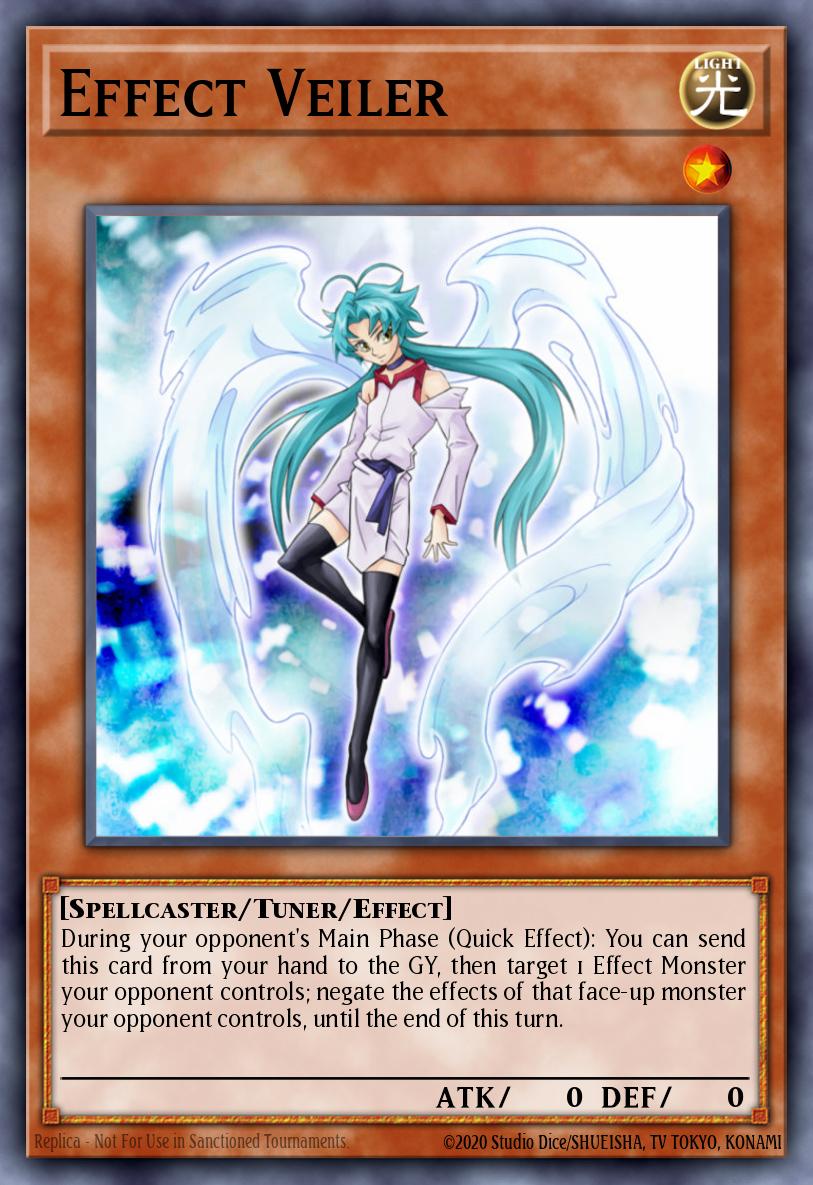 The long version: Lingering effect negation negates all the on-field effects of a monster once that negation resolves fully. Lingering effect negation refers to any kind of effect negation that resolves once fully, and then sort of sticks onto a monster like glue. Some players even use dice as markers to indicate that a monster has a lingering negation stuck to it (although this is not allowed at big events since it counts as note taking).
The long version: Lingering effect negation negates all the on-field effects of a monster once that negation resolves fully. Lingering effect negation refers to any kind of effect negation that resolves once fully, and then sort of sticks onto a monster like glue. Some players even use dice as markers to indicate that a monster has a lingering negation stuck to it (although this is not allowed at big events since it counts as note taking).In sticking to its effects, it does not check where the monster is when that monster’s effect resolves. All on-field effects are negated, even if that monster leaves the field during the same chain. Examples of this kind of negation are Effect Veiler, Infinite Impermanence, and Breakthrough Skill. They all negate in the same way.
Versus Skill Drain
This changes when we look at Skill Drain vs. Rescue Rabbit. Skill Drain specifically states that it only negates the effects of monsters that are face-up on the field. Since Rescue Rabbit banishes itself for cost, it is not on the field when the chain resolves. Skill Drain checks to make sure that Skill Drain itself is still on the field, as well as for the monster’s location. As it resolves, it sees that Rabbit is no longer on the field. Therefore, Skill Drain cannot negate the effect and Rescue Rabbit will resolve normally.
While Effect Veiler cannot chain to target Rabbit when Rabbit banishes itself for cost (since Rabbit is no longer on the field), a Veiler that was preemptively activated prior to Rabbit attempting to activate its effect will negate its effects successfully. The player controlling Rabbit can still attempt to activate by banishing Rabbit, but when the chain resolves that effect will be negated. This is because the effect was activated from the field where Rabbit is still being negated by the lingering effect of Veiler.
"Soft Negation"
This next section is a beast, but despite being relatively simple it’s worth reiterating because of its importance. This section is devoted almost entirely to Ghost Ogre & Snow Rabbit because of some cool stuff she does. It's worth getting these down cold in order to fully utilize her in a match.
Ghost Ogre is unique among many of the hand traps because she doesn’t say “negate” anywhere in her text. Ash Blossom, Veiler, and Impermanence specifically negate cards. A Ghost Ogre that is chained to the effect to Gouki Suprex will destroy Suprex at resolution, but Suprex’s effect will still resolve normally and Special Summon a Gouki monster.
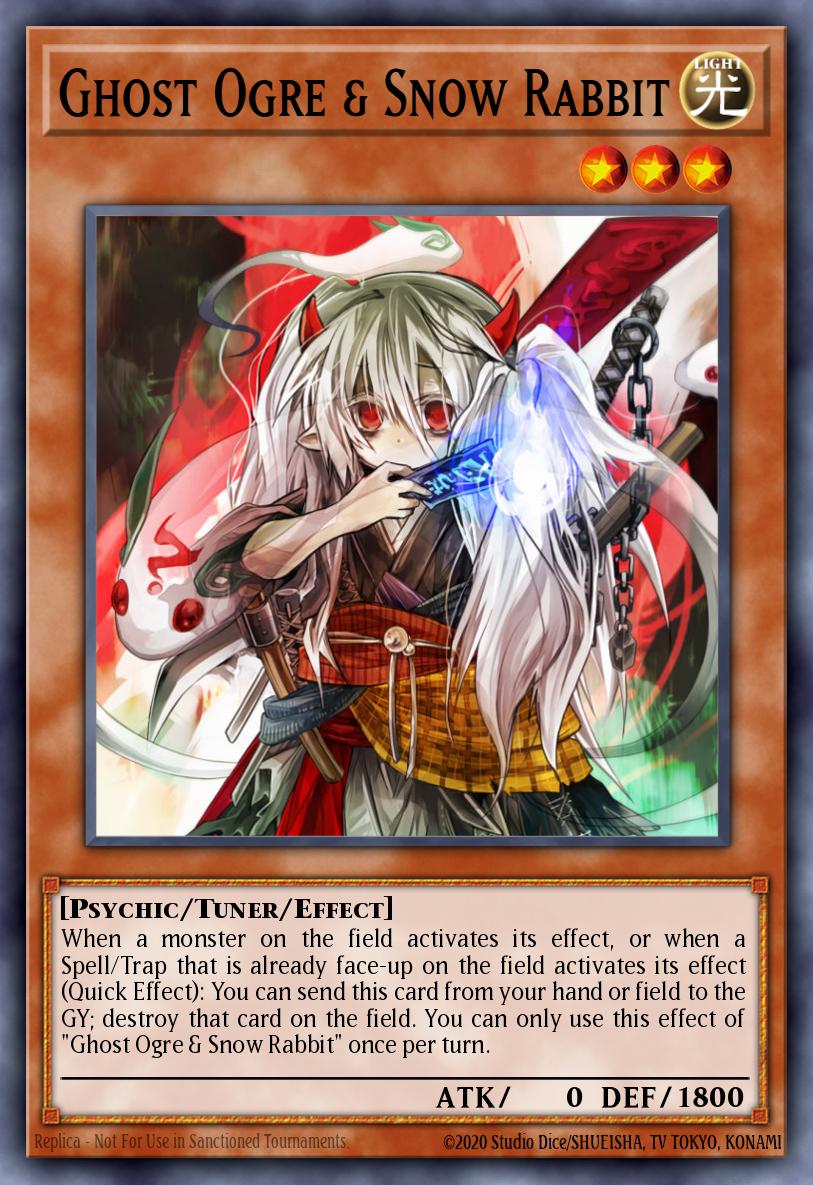 However, there are A LOT of cards that Ghost Ogre prevents from resolving.
However, there are A LOT of cards that Ghost Ogre prevents from resolving.There are two main instances when this happens.
Ghost Ogre vs. Continuous Spells and Traps
The first is against Continuous Spell/Trap cards. This applies also to Field Spells, but I will be lumping Field Spells with Continuous Spells since they function very similarly for our purposes here. In Yugioh, a continuous Spell/Trap must be on the field at resolution in order to apply its effect. Chaining Mystical Space Typhoon to Raigeki will not negate Raigeki, and Raigeki will resolve normally. However, chaining Mystical Space Typhoon to Zoodiac Barrage will prevent Barrage from resolving. The logic is that Continuous Spell/Traps must be continuously active in order for their effects to work properly.
Applying the same logic to Ghost Ogre, a Ghost Ogre that is chained to continuous Spell/Trap effects will prevent those effects from resolving. They are not technically negated, but their effects will not resolve. It’s incredibly nuanced, but the outcome is the same. We refer to this instance unofficially as “soft negating.” (Note: This is strictly an unofficial term. Konami doesn't use this specific language when discussing rulings.)
There are a lot of relevant cards that Ghost Ogre “soft negates.” A Ghost Ogre chained to either effect of Sky Striker Mecha Modules - Multirole will soft negate it outright. A Ghost Ogre chained to the second effect of Union Hangar will both destroy Hangar and prevent a Union monster from being equipped.
The important thing to remember is that Ghost Ogre only works against cards that are already face-up on the field prior to that chain. For instance, you cannot use Ghost Ogre against Union Hangar's first effect, since it is an initial activation effect of a continuous card. Moreover, a player could flip up Personal Spoofing and use its effect in that same chain link by paying its cost. You cannot chain Ghost Ogre in this instance, since Spoofing was face-down prior to this chain.
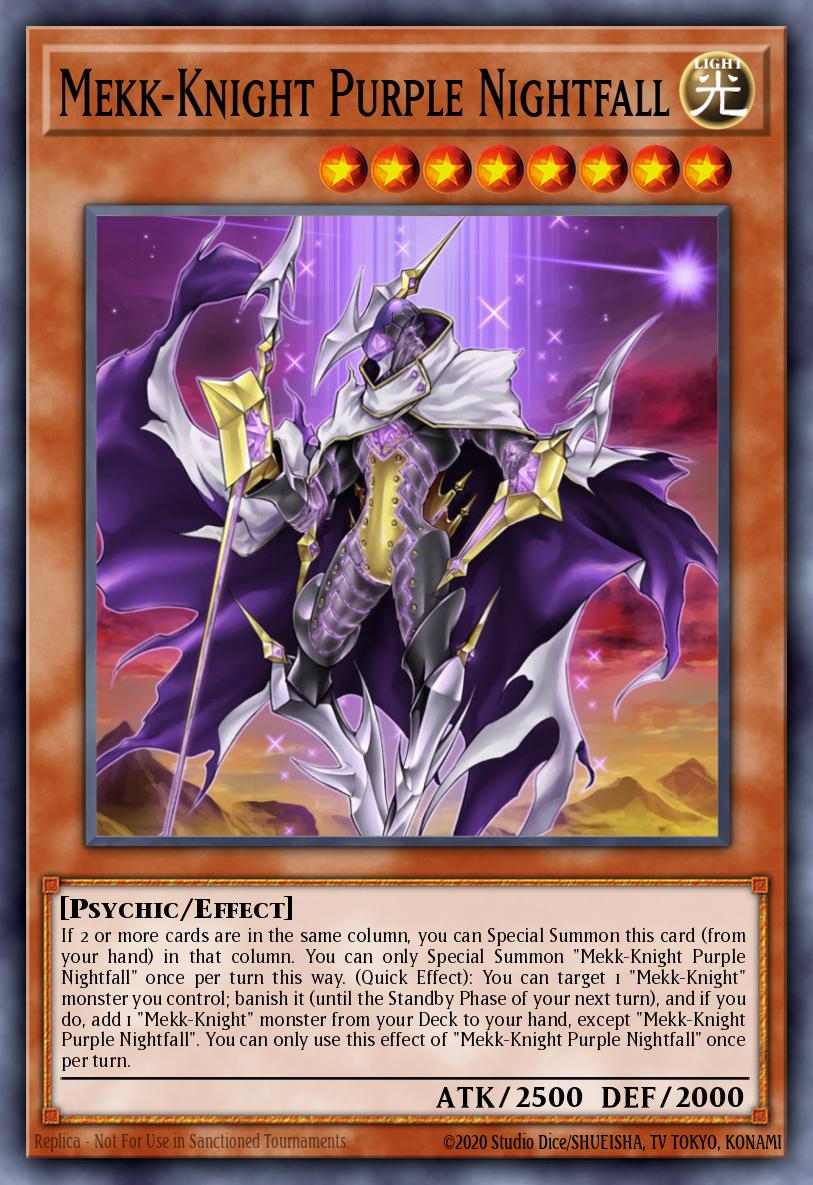
Ghost Ogre vs. Various Monsters
Most of this topic has been spent discussing Spells and Traps, but Ghost Ogre soft negates certain monsters as well. Some monsters have effects that interact with themselves or specific zones during an effect resolution.
Mekk-Knight Purple Nightfall can choose any Mekk-Knight to banish and then search a Mekk-Knight card. It can even target itself. However, it must banish the targeted card in order for the search effect to resolve correctly. If Ghost Ogre is chained to a Nightfall that targeted itself, Nightfall will just be destroyed and “soft negated”. Nothing can be banished, so nothing will be searched. It’s a pretty powerful exchange in favor of Ghost Ogre.
Remember, this does not apply if Nightfall targeted a different monster such as Mekk-Knight Blue Sky. Remember, Ghost Ogre does NOT actually negate. Since that monster should still be on the field when Nightfall resolves, Nightfall's effect will resolve normally banishing the targeted Blue Sky, despite Nightfall being destroyed by Ghost Ogre.
Alternatively, many Link Monsters interact with zones they point to at resolution. When Summon Sorceress resolves, she summons a monster from the deck to a zone she points to. However, if she leaves the field after activating, she will no longer be pointing to any zones. Therefore, a Ghost Ogre chained to Summon Sorceress will soft negate her effect. Summon Sorceress gets destroyed, and nothing will be summoned.
Similarly, a Ghost Ogre chained to SPYRAL Double Helix will prevent anything from being Special Summoned. At resolution, Double Helix's effect must add a card from either the Deck or Graveyard to the hand.
Additional Notes
Remember, I only used Ghost Ogre as an example for this. There are many other cards that function similarly that would get similar results. Yugioh card rulings rely on precedent set by previous card rulings that worked the same way. The above mentioned cards can be removed with big stuff like ABC - Dragon Buster's effect to "soft negate" or smaller stuff like Raigeki Break. What's important is to understand why these continuous effects fail to resolve in these instances. By doing so, you utilize more fully the cards at your disposal and improve your technical play.
The “then” Conjunction in Sky Striker Spells
The Sky Striker Spell cards follow this wording pattern: “Do A, then, if you have 3 of more Spell Card in your GY, do B”. Sky Striker Maneuver - Afterburners!, for example, says: “Target 1 monster on the field; destroy it, then, if you have 3 of more Spells in your GY, you can destroy 1 Spell/Trap on the field.
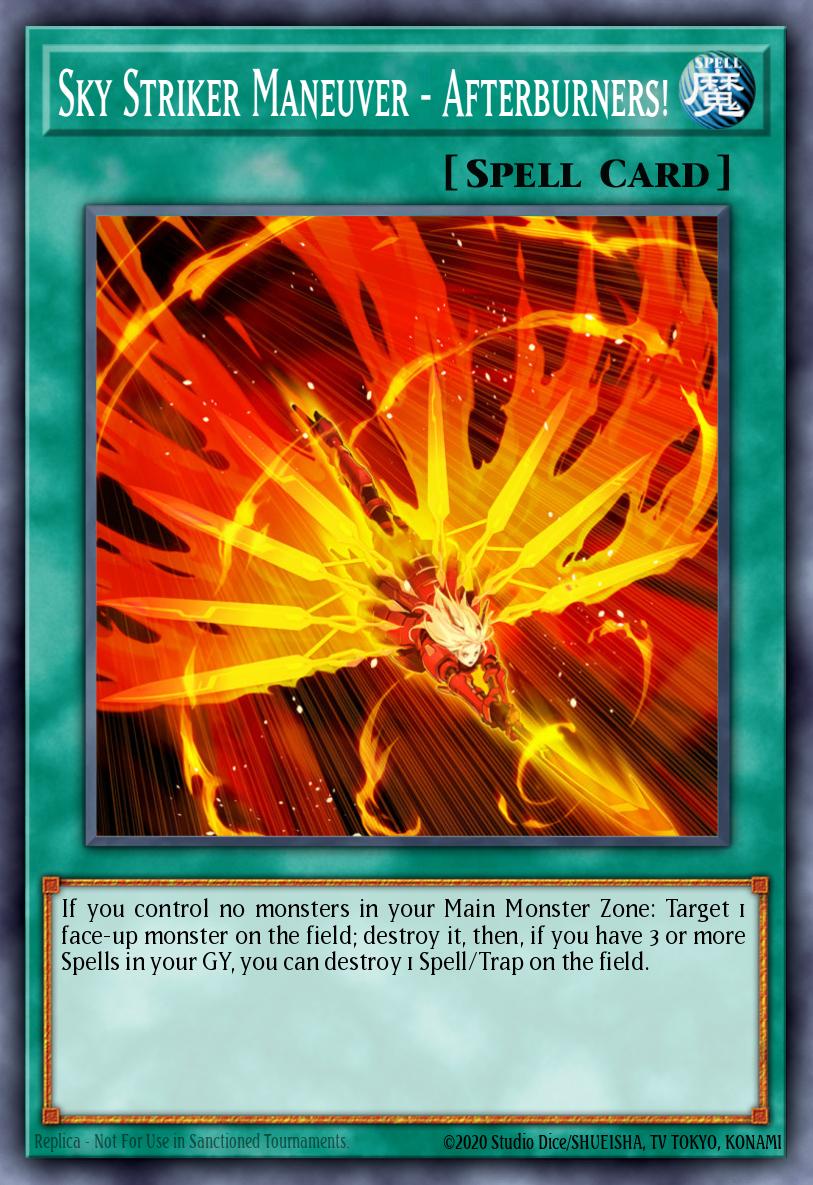
The crucial part of this card’s wording is the “then” aspect. In Yugioh, all effects worded this way must resolve in sequence successfully, or else the effect stops. For Afterburner, it must destroy the targeted card before the rest of the effect can resolve. It is impossible to destroy a monster without first targeting it. Furthermore, it is impossible to destroy a S/T unless Afterburner successfully destroys the targeted monster with its own effect.
How to Apply This Knowledge
Suppose the monster is no longer on the field when Afterburner resolves. Let’s say it was tributed to pay the cost of Enemy Controller. Therefore, when Afterburner resolves at the end of the chain, it will not be able to destroy a Spell/Trap because Afterburner did not get to destroy the targeted monster.
This is important because it applies down the line in stopping portions of many of the Sky Striker Spells. You can use this to your advantage by preventing them from resolving fully.
An Example
Suppose you have a powerful floodgate like Rivalry of Warlords that you want to protect. Your opponent activates Afterburner targeting your Knightmare Phoenix. Assume further that they have 3 Spells in their Graveyard. Therefore, your Rivalry, which is your only Spell/Trap, is also in danger of destruction. You can chain the first effect of Firewall Dragon to return Phoenix to the hand in order to protect your Rivalry. When Afterburner goes to resolve, since Phoenix is no longer on the field, Afterburner fizzles and destroys nothing.
As discussed in my previous article analyzing Sky Striker, chaining a Sky Striker Mecha - Widow Anchor to another Widow Anchor will prevent the latter one from stealing the monster. In order to successfully take control, Widow Anchor must successfully negate the monster's effects.
You can apply this logic down the line with other cards worded similarly to the Sky Striker Spells. If the monster targeted by Infinite Impermanence does not get its effects negated by that same Infinite Impermanence (either because it left the field, or another card higher in the chain negated the targeted card's effects), then Infinite Impermanence will not negate Spell/Trap cards in its column.
For more on conjunctions in Yugioh, refer to the official Yugioh blog here where they break down how the conjunctions work.
How Does Ghost Belle Work?
Ghost Belle & Haunted Mansion can negate PSY-Framegear Gamma’s effect, even if there is no PSY-Frame Driver in the Graveyard.
Why?
There are two reasons. The first is that Belle’s trigger requirements are just if the monster has one of Belle’s criteria mentioned somewhere in the resolving part of its effect. That might seem convoluted, but it’s clarified by looking at the second reason. Even if there is no Driver in the Graveyard when Gamma activates, Belle can still negate. What matters is that it is hypothetically possible for a Driver to enter the Graveyard at a later point in the same chain. The player could chain a Twin Twisters in that same chain discarding Driver, and then try to revive it with Gamma to get maximum value. Because of this reason, Belle understands that it’s hypothetically possible for Gamma for revive a Driver, and therefore triggers.
A quick side note about Gamma. Since Belle does not destroy and Gamma does not discard itself, it remain in hands after Belle negates it.
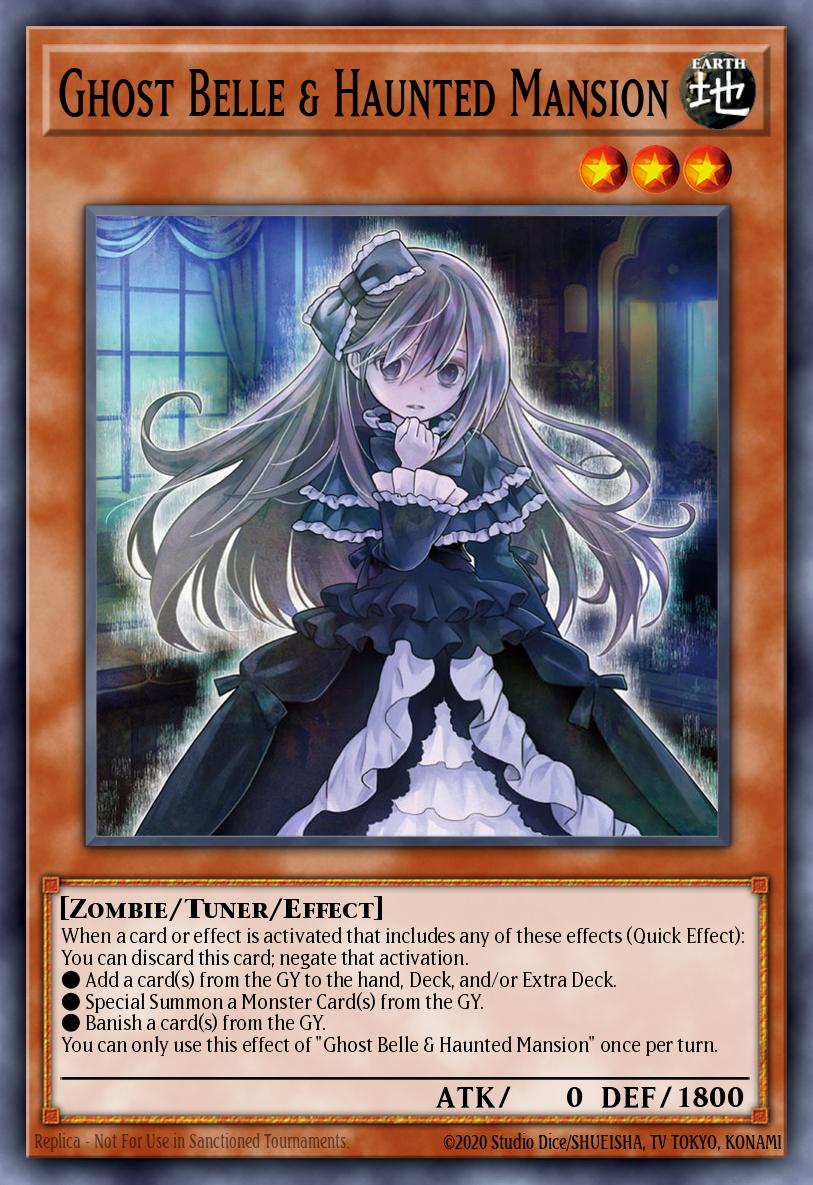
Why is this Important?
Well, it gives Belle a wider pool of cards that she can negate. In fact, Belle negates a lot of stuff, not just clearer cards like Called by the Grave, Monster Reborn, and Soul Charge. Along with Gamma, here are some other relevant cards that Belle negates, even if they seem counter-intuitive:
- Belle can negate Invocation’s activation effect, even if neither player has any monster in the Graveyard. (Note: this does not work when they have Magical Meltdown face-up on the field, as Meltdown prevents Fusion spells from being negated)
- Belle can negate Dupe Frog’s Graveyard effect, even if that player has no Frog monsters in the Graveyard. (Note: Since Belle says “negate the activation,” you can also use her during the Damage Step. You cannot use Ash Blossom & Joyous Spring against Dupe Frog in the Damage Step because she says “negate that effect.”)
- Belle can negate Shiranui Spiritmaster’s first effect.
- Belle can negate Kozmojo
And so forth. It doesn't come up that much, but it clarifies how Belle really works makes her even better as a card.
Sometimes in a match, I have had a player say the following: “Belle cannot negate my SPYRAL Double Helix because I’m not planning on reviving a SPYRAL monster.” While I can’t say for certain what my opponent is planning, what I can say is that that is not how Belle works. Belle checks for whether a resolving effect can hypothetically move a card from the Graveyard. Many effects, like Double Helix, make the decision at the card's resolution rather than at the activation. Therefore, given that possibility of reviving a card, Belle will trigger no matter what.
Triggering Against Small Components Within Longer Effects
Some cards have effects that kind of randomly add in the option to summon a monster from the Graveyard, or include a small Special Summon effect in the middle of a complicated effect. Belle can negate these kinds of effects completely, not just the part that involves the revival. Belle triggers if even just one component of the effect hypothetically fits her criteria.
A great example is SPYRAL Sleeper's Graveyard effect. Sleeper's effect destroys the controller's entire board, and summons a SPYRAL Super Agent afterwards. It can summon a Super Agent from the Deck, the hand, and conveniently, the Graveyard. Since it mentions the mere possibility of summoning from the Graveyard just once throughout this long effect, Ghost Belle can negate this entire effect. No cards will be destroyed, and the effect will be stopped outright. Use this to stop your opponent from getting a Super Agent, or use it to stop your own SPYRAL Sleeper from killing your entire board when it dies.
Trickstar Light Stage vs. Waking the Dragon
If Waking the Dragon is sent to the Graveyard because of the effect of Trickstar Light Stage, it does not trigger.
Why?
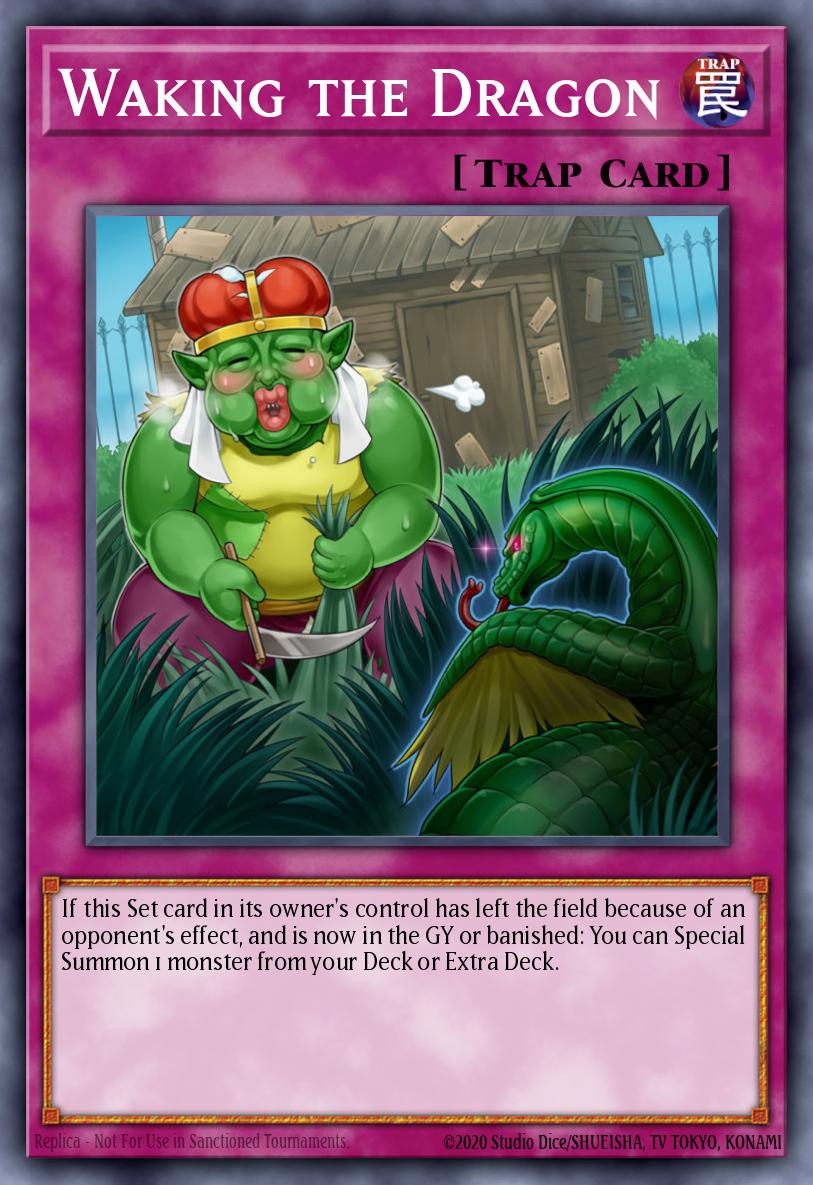 It might seem counter intuitive, but it’s because of some very nuanced wording on Light Stage. When Light Stage resolves during the End Phase, the choice between activating the set card or sending it to the Graveyard is delegated to the opponent. Since Waking can’t activate, the player sends the targeted Waking to the Graveyard. Since the action was delegated to the opponent, Waking is technically not sent to the Graveyard directly because of a card effect. It’s not by the effect of Light Stage, but instead by the action of the player, since they made the choice. Ironically, though forced to make that choice, it was still their action.
It might seem counter intuitive, but it’s because of some very nuanced wording on Light Stage. When Light Stage resolves during the End Phase, the choice between activating the set card or sending it to the Graveyard is delegated to the opponent. Since Waking can’t activate, the player sends the targeted Waking to the Graveyard. Since the action was delegated to the opponent, Waking is technically not sent to the Graveyard directly because of a card effect. It’s not by the effect of Light Stage, but instead by the action of the player, since they made the choice. Ironically, though forced to make that choice, it was still their action.If it makes it any easier to understand, think of Trickstar Light Stage's effect being applied to the player rather than the targeted card. Therefore in this instance, Waking is being sent by the player, who was originally being affected by Light Stage.
Another Scenario
The reason why this happens comes up again in another meta relevant ruling. This specific interaction came up for me at a regional in Chicago when I played SPYRAL against a Trickstar opponent.
My opponent controls Chaos Hunter and ends his own Battle Phase. Despite Chaos Hunter’s effect being online, I activated Evenly Matched at the end of his Battle Phase. He said that I cannot on account of Chaos Hunter's effect, and we called the judge for a review. The judge ruled in my favor, arguing that the player doing the banishing is the player controlling Chaos Hunter, and therefore her effect is not applying.
Evenly Matched delegates the action of banishing to its opponent. It's another instance where a card affects a player rather than the cards directly. Chaos Hunter says that the opponent cannot banish cards, who in this instance is the one activating Evenly. However, when Evenly resolves, the person controlling Chaos Hunter is doing the banishing. It’s incredibly slight, but it makes all the difference. Therefore, Chaos Hunter’s effect does not apply, and Evenly Matched works normally.
That's all from me for now. Hopefully this article showed the importance of nuanced differences between individual words when analyzing card text interactions. Next time we will look at more intricate card rulings worth studying before going to your next tournament.
Wish you the best.
-wiedergeburt




